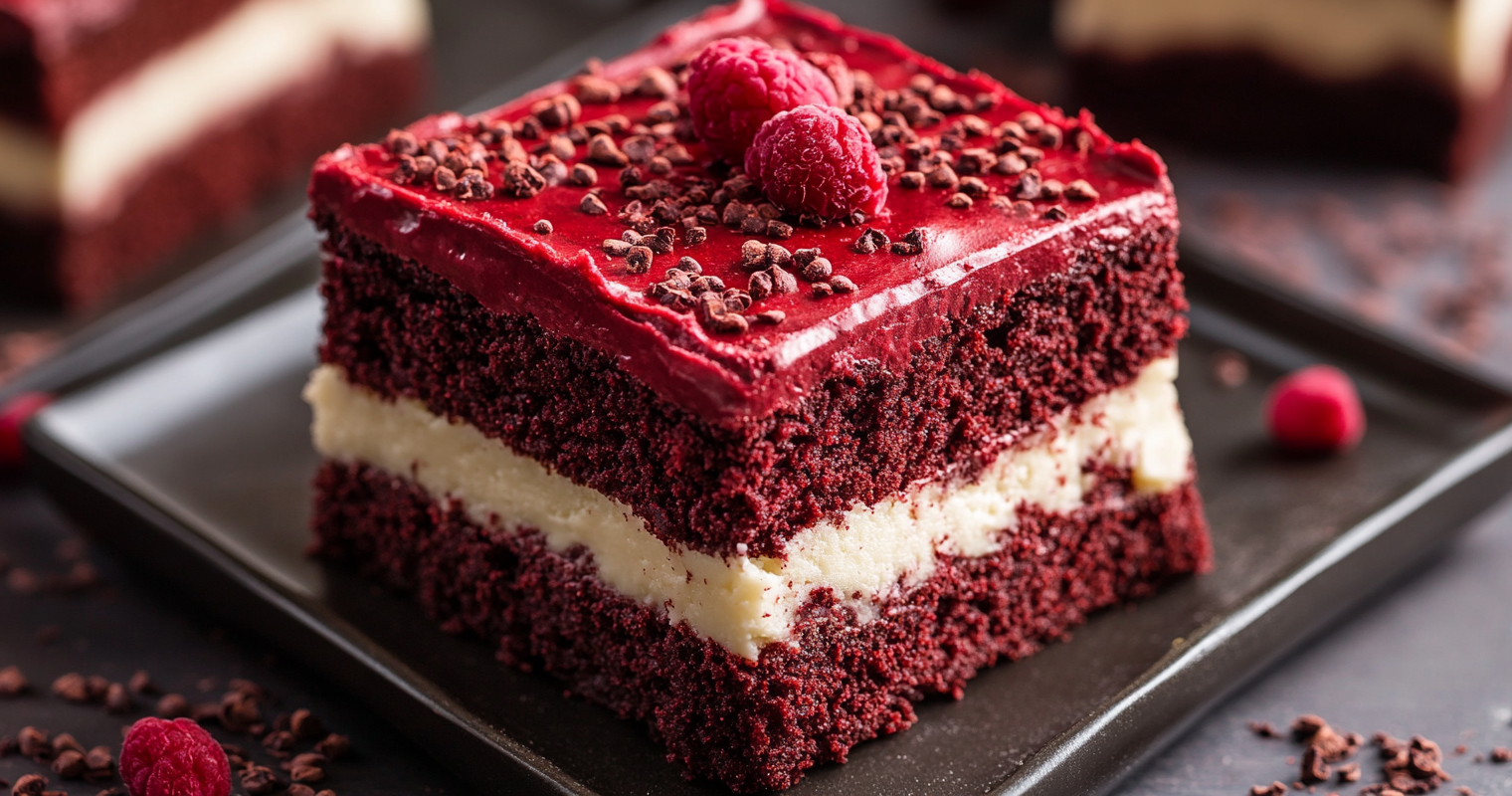Red velvet cookies and chocolate cookies are both widely loved treats. While they share similarities, they offer distinct flavors, textures, and visual appeal. At first glance, they may seem similar. Both are rich in flavor and have a moist, chewy texture. However, their differences become clear when you look at the ingredients and flavor profiles.
This post explores the distinctions between red velvet and chocolate cookies. Whether you’re a chocolate lover or a fan of red velvet’s vibrant color, understanding the differences will help you appreciate each one. So, what makes red velvet stand out?
Ingredients: Cocoa is Key, But Used Differently
Both red velvet and chocolate cookies use cocoa powder. However, the amount and its role in the flavor differ between the two.
Chocolate cookies revolve around the bold taste of cocoa. Most recipes use a lot of cocoa powder, resulting in a strong chocolate flavor. Some even add chocolate chips or melted chocolate for extra indulgence.
Red velvet cookies, on the other hand, use much less cocoa. The small amount of cocoa gives them a mild chocolate taste, but it doesn’t dominate. Instead, the flavor balances between cocoa, buttermilk, and vinegar. These ingredients contribute to red velvet’s smooth texture and subtle tang.
The difference in the role of cocoa sets these two cookies apart. Red velvet cookies rely on balance, while chocolate cookies celebrate the richness of chocolate. Curious how cocoa interacts with other ingredients in red velvet? Check out this breakdown of what makes red velvet brownies special.
Buttermilk and Vinegar: The Red Velvet Signature
A defining difference between red velvet and chocolate cookies is the inclusion of buttermilk and vinegar in red velvet recipes. These ingredients give red velvet its unique flavor and texture.
- Buttermilk adds a tangy flavor that sets red velvet apart from the straightforward sweetness of chocolate cookies. It also helps create a softer, more tender cookie.
- Vinegar might seem like an unusual ingredient, but it’s crucial in red velvet recipes. It reacts with baking soda, helping the cookies rise and giving them a light, airy texture. This reaction is what creates the velvety texture that makes red velvet so irresistible.
Chocolate cookies, by contrast, rely on butter and sugar to achieve a rich, dense texture. They don’t need the tanginess or lightness that vinegar and buttermilk provide. For more on how these ingredients impact red velvet’s flavor and texture, check out this article on what makes red velvet cake different.
Visual Appeal: Red Food Coloring vs. Natural Cocoa
One of the most obvious differences is the color. Red velvet cookies are instantly recognizable by their bold red hue, which is usually achieved with red food coloring.
The red color gives red velvet cookies a festive look, making them a popular choice for holidays. Some bakers opt for natural food coloring, like beet juice, but most use traditional red dye. The vibrant color makes them stand out, even before you take a bite.
In contrast, chocolate cookies get their deep brown color naturally from the cocoa powder. The rich, dark hue is classic and comforting, reflecting the indulgent nature of chocolate cookies. No extra coloring is needed to achieve their iconic look.
Want to see how red velvet’s color and texture come together in another dessert? Check out this recipe for red velvet brownies.
Flavor: Bold and Rich vs. Subtle and Complex
The flavor difference between red velvet and chocolate cookies is another key distinction.
Chocolate cookies deliver a bold, rich chocolate taste. The large amount of cocoa powder, combined with butter and sugar, gives them a deep sweetness that satisfies chocolate lovers. The chocolate flavor dominates, and the sweetness balances out the slight bitterness of the cocoa.
Red velvet cookies, however, offer a more layered flavor. The cocoa is mild, providing just a hint of chocolate. But the real star is the combination of tangy buttermilk and vinegar, which gives the cookies a subtle complexity. The result is a smooth, velvety taste that feels more sophisticated than the straightforward richness of chocolate cookies.
For a more detailed explanation of why red velvet tastes different from chocolate, check out this article on why red velvet tastes unique.
Texture: Velvety and Soft vs. Fudgy and Dense
In terms of texture, red velvet and chocolate cookies also have distinct characteristics.
- Chocolate cookies are often dense and fudgy. The high cocoa content, along with butter and sugar, creates a chewy, thick texture. This makes chocolate cookies rich and satisfying, with each bite delivering a full chocolate experience.
- Red velvet cookies, true to their name, have a soft, velvety texture. The buttermilk and vinegar make the cookies light and tender, while the small amount of cocoa adds a touch of richness. They almost melt in your mouth, offering a smoother, lighter experience compared to the heavier feel of chocolate cookies.
If you enjoy red velvet’s velvety texture, you might want to try red velvet brownies. They take this texture to another level with a fudgy bite that still retains the smoothness of red velvet.
Frosting: The Cream Cheese Factor
Another major difference between red velvet and chocolate cookies is the use of frosting.
- Red velvet cookies are often paired with cream cheese frosting. This tangy, sweet frosting complements the subtle chocolate flavor and enhances the overall experience. The rich creaminess balances out the slight tang from the vinegar and buttermilk, making the cookie even more satisfying.
- Chocolate cookies, on the other hand, usually don’t need frosting. Their bold flavor stands alone, although some recipes may include a drizzle of chocolate or a sprinkle of powdered sugar. The focus remains on the richness of the chocolate.
The addition of cream cheese frosting is one of the reasons red velvet desserts are so popular. It adds a complementary flavor and texture that chocolate cookies don’t need, but red velvet thrives on.
Are Red Velvet Cookies Just Chocolate Cookies with Red Food Coloring?
A common misconception is that red velvet cookies are just chocolate cookies with added red food coloring. However, this is far from true.
While both cookies contain cocoa powder, red velvet uses much less, and the flavor is much milder. Additionally, the inclusion of buttermilk and vinegar in red velvet cookies creates a flavor and texture that chocolate cookies can’t replicate. The cream cheese frosting is another key difference that adds to the complexity of red velvet cookies.
On the other hand, chocolate cookies focus on rich, deep cocoa flavor. They are all about indulgence and sweetness, with the cocoa taking center stage.
If you’re interested in learning more about how these two desserts differ, you can explore the differences between red velvet and chocolate, which explains how both red velvet and chocolate cakes—and, by extension, cookies—stand on their own.
Variations of Red Velvet and Chocolate Cookies
Both red velvet and chocolate cookies are incredibly versatile. There are countless variations of each that allow bakers to get creative.
Popular Red Velvet Cookie Variations:
- Red Velvet Crinkle Cookies: These cookies have a cracked, crinkled surface and are often dusted with powdered sugar, giving them a visually appealing contrast against the red color.
- Red Velvet Sandwich Cookies: Two red velvet cookies are sandwiched together with cream cheese frosting in the middle for an extra indulgent treat.
- Red Velvet Cookie Bars: These are a thick, chewy version of red velvet cookies in bar form, offering a denser, more filling treat.
Popular Chocolate Cookie Variations:
- Double Chocolate Chip Cookies: These feature both cocoa powder and chocolate chips, delivering twice the chocolate flavor.
- Chocolate Peppermint Cookies: A seasonal favorite, these combine the rich flavor of chocolate with a hint of refreshing peppermint.
- Chocolate Espresso Cookies: A hint of espresso powder enhances the chocolate flavor and adds a subtle coffee kick to these cookies.
Both types of cookies offer endless possibilities for variation, allowing bakers to experiment and find their perfect combination.
Conclusion: Two Unique, Delicious Cookies
While red velvet cookies and chocolate cookies share some ingredients, their differences make each cookie unique. Chocolate cookies provide a rich, intense chocolate experience, with a dense, chewy texture. Meanwhile, red velvet cookies offer a more subtle flavor with a smooth, velvety texture, complemented by a tangy cream cheese frosting.
The bright red color and tangy frosting make red velvet cookies a standout for special occasions. On the other hand, the classic appeal of chocolate cookies makes them a go-to for anyone craving something rich and sweet.
If you’re interested in exploring more about red velvet desserts, from cakes to brownies, take a look at the delicious recipes available on Savannah Recipes and learn more about what makes red velvet so special.

